Development of Robust CuNi Bimetallic Catalysts for Selective Hydrogenation of Furfural to Furfuryl Alcohol under Mild Conditions
Abstract
1. Introduction
2. Results and Discussion
2.1. Catalyst Synthesis and Characterization
2.2. Hydrogenation Performance
2.3. Mechanism Investigation
| Catalysts | T/°C | H2/MPa | t/h | Furfural Conversion/% | Furfuryl Alcohol Selectivity/% | Ref. |
|---|---|---|---|---|---|---|
| 0.5%Ni-10%Cu/SiO2-CA(H2) | 55 | 1 | 2 | 95.7 | 99.9 | This work |
| 0.5%Ni-10%Cu/SiO2-CA(H2) | 55 | 2 | 2 | 99.4 | 99.9 | This work |
| NiCu0.33/C | 120 | 1.5 | 12 | 96.7 | 93.8 | [34] |
| Na-Cu@TS-1 | 110 | 1 | 2 | 93 | 98.1 | [16] |
| Cu2Ni1AlOy | 120 | 1.6 | 1.5 | 98 | 99 | [35] |
| Cu3Co1/MgAlOX | 110 | 2 | 2 | 100 | 99.9 | [33] |
| CuNiOX(1/1)-150 | 150 | 3 | 0.75 | 100 | 97 | [30] |
| Cu/AC−SO3H | 105 | 0.4 | 2 | 99.9 | 99.9 | [3] |
| Pd1Cu216 | 50 | 0.15 | 7 | 40.1 | 99.9 | [36] |
| Cu/MgO-350 | 110 | 2 | 1.3 | 99.9 | 99.9 | [29] |
| CuCo/MgO-0.04 | 100 | 2 | 1 | 100 | 99.4 | [37] |
| Cu−Pt@TMS | 110 | 1 | 1.5 | 98.4 | 99.6 | [38] |
| 2-Cu/C-400 | 170 | 2 | 3 | 99.6 | 99.3 | [39] |
| NiCoCuZnFe/C- 800 | 120 | 3 | 9 | 100 | 100 | [17] |
3. Materials and Methods
3.1. Catalyst Preparation
3.2. Reaction Process
3.3. Catalyst Characterization
4. Conclusions
Supplementary Materials
Author Contributions
Funding
Data Availability Statement
Conflicts of Interest
References
- Tian, X.; Wang, Y.; Zeng, Z.; Dai, L.; Xu, J.; Cobb, K.; Ke, L.; Zou, R.; Liu, Y.; Ruan, R. Research progress on the role of common metal catalysts in biomass pyrolysis: A state-of-the-art review. Green Chem. 2022, 24, 3922–3942. [Google Scholar] [CrossRef]
- Zhao, P.; Yan, J.; Shan, B.; Zhang, Y.; Zhao, Z.; Liu, L.; Su, Z.; Cheng, W.; Xu, X. Copper nanoparticles control of carbon supported copper catalysts for dimethyl carbonate synthesis: A short review. Mol. Catal. 2023, 536, 112910. [Google Scholar] [CrossRef]
- Gong, W.; Chen, C.; Zhang, Y.; Zhou, H.; Wang, H.; Zhang, H.; Zhang, Y.; Wang, G.; Zhao, H. Efficient synthesis of furfuryl alcohol from H2-hydrogenation/transfer hydrogenation of furfural using sulfonate group modified Cu Catalyst. ACS Sustain. Chem. Eng. 2017, 5, 2172–2180. [Google Scholar] [CrossRef]
- Xu, X.; Dong, Y.; Hu, Q.; Si, N.; Zhang, C. Electrochemical hydrogen storage materials: State-of-the-art and future perspectives. Energy Fuels 2024, 38, 7579–7613. [Google Scholar] [CrossRef]
- Mariscal, R.; Maireles-Torres, P.; Ojeda, M.; Sadaba, I.; Lopez Granados, M. Furfural: A renewable and versatile platform molecule for the synthesis of chemicals and fuels. Energy Environ. Sci. 2016, 9, 1144–1189. [Google Scholar] [CrossRef]
- Li, X.; Jia, P.; Wang, T. Furfural: A promising platform compound for sustainable production of C4 and C5 chemicals. ACS Catal. 2016, 6, 7621–7640. [Google Scholar] [CrossRef]
- Zhang, J.; Chen, J. Selective transfer hydrogenation of biomass-based furfural and 5-hydroxymethylfurfural over hydrotalcite-derived copper catalysts using methanol as a hydrogen donor. ACS Sustain. Chem. Eng. 2017, 5, 5982–5993. [Google Scholar] [CrossRef]
- Zhou, K.; Chen, J.; Cheng, Y.; Chen, Z.; Kang, S.; Cai, Z.; Xu, Y.; Wei, J. Enhanced catalytic transfer hydrogenation of biomass-based furfural into 2-methylfuran over multifunctional Cu-Re bimetallic catalysts. ACS Sustain. Chem. Eng. 2020, 8, 16624–16636. [Google Scholar] [CrossRef]
- Vaidyanathan, V.K.; Saikia, K.; Kumar, P.S.; Rathankumar, A.K.; Rangasamy, G.; Saratale, G.D. Advances in enzymatic conversion of biomass derived furfural and 5-hydroxymethylfurfural to value-added chemicals and solvents. Bioresour. Technol. 2023, 378, 128975. [Google Scholar] [CrossRef]
- An, Z.; Li, J. Recent advances in the catalytic transfer hydrogenation of furfural to furfuryl alcohol over heterogeneous catalysts. Green Chem. 2022, 24, 1780–1808. [Google Scholar] [CrossRef]
- Cao, Y.; Zhang, H.; Liu, K.; Zhang, Q.; Chen, K.-J. Biowaste-derived bimetallic Ru-MoOx catalyst for the direct hydrogenation of furfural to tetrahydrofurfuryl alcohol. ACS Sustain. Chem. Eng. 2019, 7, 12858–12866. [Google Scholar] [CrossRef]
- Zhao, J.; Li, X.; Zhang, M.; Xu, Z.; Qin, X.; Liu, Y.; Han, L.; Li, G. Enhancing the catalytic performance of Co-N-C derived from ZIF-67 by mesoporous silica encapsulation for chemoselective hydrogenation of furfural. Nanoscale 2023, 15, 4612–4619. [Google Scholar] [CrossRef] [PubMed]
- Zhang, J.; Li, D.-n.; Yuan, H.-r.; Wang, S.-r.; Chen, Y. Advances on the catalytic hydrogenation of biomass-derived furfural and 5-hydroxymethylfurfural. J. Fuel Chem. Technol. 2021, 49, 1752–1766. [Google Scholar] [CrossRef]
- Chen, S.; Wojcieszak, R.; Dumeignil, F.; Marceau, E.; Royer, S. How catalysts and experimental conditions determine the selective hydroconversion of furfural and 5-hydroxymethylfurfural. Chem. Rev. 2018, 118, 11023–11117. [Google Scholar] [CrossRef]
- Huang, S.; Yang, N.; Wang, S.; Sun, Y.; Zhu, Y. Tuning the synthesis of platinum-copper nanoparticles with a hollow core and porous shell for the selective hydrogenation of furfural to furfuryl alcohol. Nanoscale 2016, 8, 14104–14108. [Google Scholar] [CrossRef]
- Cao, P.; Lin, L.; Qi, H.; Chen, R.; Wu, Z.; Li, N.; Zhang, T.; Luo, W. Zeolite-encapsulated Cu nanoparticles for the selective hydrogenation of furfural to furfuryl alcohol. ACS Catal. 2021, 11, 10246–10256. [Google Scholar] [CrossRef]
- Tu, R.; Liang, K.; Sun, Y.; Wu, Y.; Lv, W.; Jia, C.Q.; Jiang, E.; Wu, Y.; Fan, X.; Zhang, B.; et al. Ultra-Dilute high-entropy alloy catalyst with core-shell structure for high-active hydrogenation of furfural to furfuryl alcohol at mild temperature. Chem. Eng. J. 2023, 452, 139526. [Google Scholar] [CrossRef]
- Kalong, M.; Hongmanorom, P.; Ratchahat, S.; Koo-amornpattana, W.; Faungnawakij, K.; Assabumrungrat, S.; Srifa, A.; Kawi, S. Hydrogen-free hydrogenation of furfural to furfuryl alcohol and 2-methyl-furan over Ni and Co-promoted Cu/γ-Al2O3 catalysts. Fuel Process. Technol. 2021, 214, 106721. [Google Scholar] [CrossRef]
- Liu, S.; Govindarajan, N.; Chan, K. Understanding activity trends in furfural hydrogenation on transition metal surfaces. ACS Catal. 2022, 12, 12902–12910. [Google Scholar] [CrossRef]
- Jimenez-Gomez, C.P.; Cecilia, J.A.; Franco-Duro, F.I.; Pozo, M.; Moreno-Tost, R.; Maireles-Torres, P. Promotion effect of Ce or Zn oxides for improving furfuryl alcohol yield in the furfural hydrogenation using inexpensive Cu-based catalysts. Mol. Catal. 2018, 455, 121–131. [Google Scholar] [CrossRef]
- Thongratkaew, S.; Luadthong, C.; Kiatphuengporn, S.; Khemthong, P.; Hirunsit, P.; Faungnawakij, K. Cu-Al spinel-oxide catalysts for selective hydrogenation of furfural to furfuryl alcohol. Catal. Today 2021, 367, 177–188. [Google Scholar] [CrossRef]
- Yuan, H.; Hong, M.; Huang, X.; Qiu, W.; Dong, F.; Zhou, Y.; Chen, Y.; Gao, J.; Yang, S. Graphene chainmail shelled dilute Ni―Cu Alloy for selective and robust aqueous phase catalytic hydrogenation. Adv. Sci. 2024, 11, 2304349. [Google Scholar] [CrossRef] [PubMed]
- Zhou, P.; Li, L.; Mosali, V.S.S.; Chen, Y.; Luan, P.; Gu, Q.; Turner, D.R.; Huang, L.; Zhang, J. Electrochemical hydrogenation of furfural in aqueous acetic acid media with enhanced 2-methylfuran selectivity using CuPd bimetallic catalysts. Angew. Chem.-Int. Ed. 2022, 61, e202117809. [Google Scholar] [CrossRef]
- Rao, T.U.; Suchada, S.; Choi, C.; Machida, H.; Huo, Z.; Norinaga, K. Selective hydrogenation of furfural to tetrahydrofurfuryl alcohol in 2-butanol over an equimolar Ni-Cu-Al catalyst prepared by the co-precipitation method. Energy Convers. Manag. 2022, 265, 115736. [Google Scholar] [CrossRef]
- Yu, C.; Fu, J.; Muzzio, M.; Shen, T.; Su, D.; Zhu, J.; Sun, S. CuNi nanoparticles assembled on graphene for catalytic methanolysis of ammonia borane and hydrogenation of nitro/nitrile compounds. Chem. Mater. 2017, 29, 1413–1418. [Google Scholar] [CrossRef]
- Fu, Y.; Wang, S.; Wang, Y.; Wei, P.; Shao, J.; Liu, T.; Wang, G.; Bao, X. Enhancing electrochemical nitrate reduction to ammonia over Cu nanosheets via facet tandem catalysis. Angew. Chem.-Int. Ed. 2023, 62, e202303327. [Google Scholar] [CrossRef] [PubMed]
- Yen, H.; Seo, Y.; Kaliaguine, S.; Kleitz, F. Role of metal-support interactions, particle size, and metal-metal synergy in CuNi nanocatalysts for H2 generation. ACS Catal. 2015, 5, 5505–5511. [Google Scholar] [CrossRef]
- Weerachawanasak, P.; Krawmanee, P.; Inkamhaeng, W.; Aires, F.J.C.S.; Sooknoi, T.; Panpranot, J. Development of bimetallic Ni-Cu/SiO2 catalysts for liquid phase selective hydrogenation of furfural to furfuryl alcohol. Catal. Commun. 2021, 149, 106221. [Google Scholar] [CrossRef]
- Zhang, J.; Jia, Z.; Yu, S.; Liu, S.; Li, L.; Xie, C.; Wu, Q.; Zhang, Y.; Yu, H.; Liu, Y.; et al. Regulating the Cu0-Cu+ ratio to enhance metal-support interaction for selective hydrogenation of furfural under mild conditions. Chem. Eng. J. 2023, 468, 143755. [Google Scholar] [CrossRef]
- Fang, W.; Liu, S.; Steffensen, A.K.; Schill, L.; Kastlunger, G.; Riisager, A. On the role of Cu+ and CuNi alloy phases in mesoporous CuNi catalyst for furfural hydrogenation. ACS Catal. 2023, 13, 8437–8444. [Google Scholar] [CrossRef]
- Du, J.; Zhang, J.; Sun, Y.; Jia, W.; Si, Z.; Gao, H.; Tang, X.; Zeng, X.; Lei, T.; Liu, S.; et al. Catalytic transfer hydrogenation of biomass-derived furfural to furfuryl alcohol over in-situ prepared nano Cu-Pd/C catalyst using formic acid as hydrogen source. J. Catal. 2018, 368, 69–78. [Google Scholar] [CrossRef]
- Liao, X.; Zhao, H.; Liu, R.; Luo, H.; Lv, Y.; Liu, P. Highly efficient and selective hydrogenation of furfural to furfuryl alcohol and cyclopentanone over Cu-Ni bimetallic Catalysts: The crucial role of CuNi alloys and Cu+ species. J. Catal. 2024, 436, 115603. [Google Scholar] [CrossRef]
- Zhao, H.; Liao, X.; Cui, H.; Zhu, M.; Hao, F.; Xiong, W.; Luo, H.; Lv, Y.; Liu, P. Efficient Cu-Co bimetallic catalysts for the selective hydrogenation of furfural to furfuryl alcohol. Fuel 2023, 351, 128887. [Google Scholar] [CrossRef]
- Tang, F.; Wang, L.; Dessie Walle, M.; Mustapha, A.; Liu, Y.-N. An alloy chemistry strategy to tailoring the d-band center of Ni by Cu for efficient and selective catalytic hydrogenation of furfural. J. Catal. 2020, 383, 172–180. [Google Scholar] [CrossRef]
- Luo, L.; Yuan, F.; Zaera, F.; Zhu, Y. Catalytic hydrogenation of furfural to furfuryl alcohol on hydrotalcite-derived CuxNi3-xAlOy mixed-metal oxides. J. Catal. 2021, 404, 420–429. [Google Scholar] [CrossRef]
- Islam, M.J.; Granollers Mesa, M.; Osatiashtiani, A.; Manayil, J.C.; Isaacs, M.A.; Taylor, M.J.; Tsatsos, S.; Kyriakou, G. PdCu single atom alloys supported on alumina for the selective hydrogenation of furfural. Appl. Catal. B: Environ. 2021, 299, 120652. [Google Scholar] [CrossRef]
- Zhang, J.; Liu, Y.; Jia, Z.; Yu, S.; Liu, S.; Li, L.; Wu, Q.; Yu, H.; Liu, Y.; Jiang, X.; et al. Selective hydrogenation of furfural to furfuryl alcohol over copper-cobalt bimetallic catalyst. Chem. Eng. J. 2024, 490, 151677. [Google Scholar] [CrossRef]
- Wang, S.; Lv, Y.; Ren, J.; Xu, Z.; Yang, Q.; Zhao, H.; Gao, D.; Chen, G. Ultrahigh selective hydrogenation of furfural enabled by modularizing hydrogen dissociation and substrate activation. ACS Catal. 2023, 13, 8720–8730. [Google Scholar] [CrossRef]
- Wang, C.; Liu, Y.; Cui, Z.; Yu, X.; Zhang, X.; Li, Y.; Zhang, Q.; Chen, L.; Ma, L. In situ synthesis of Cu nanoparticles on carbon for highly selective hydrogenation of furfural to furfuryl alcohol by using pomelo peel as the carbon ssource. ACS Sustain. Chem. Eng. 2020, 8, 12944–12955. [Google Scholar] [CrossRef]
- Yu, W.; Xiong, K.; Ji, N.; Porosoff, M.D.; Chen, J.G. Theoretical and experimental studies of the adsorption geometry and reaction pathways of furfural over FeNi bimetallic model surfaces and supported catalysts. J. Catal. 2014, 317, 253–262. [Google Scholar] [CrossRef]
- Meng, X.; Wang, L.; Chen, L.; Xu, M.; Liu, N.; Zhang, J.; Yang, Y.; Wei, M. Charge-separated metal-couple-site in NiZn alloy catalysts towards furfural hydrodeoxygenation reaction. J. Catal. 2020, 392, 69–79. [Google Scholar] [CrossRef]
- Sitthisa, S.; An, W.; Resasco, D.E. Selective conversion of furfural to methylfuran over silica-supported NiFe bimetallic catalysts. J. Catal. 2011, 284, 90–101. [Google Scholar] [CrossRef]

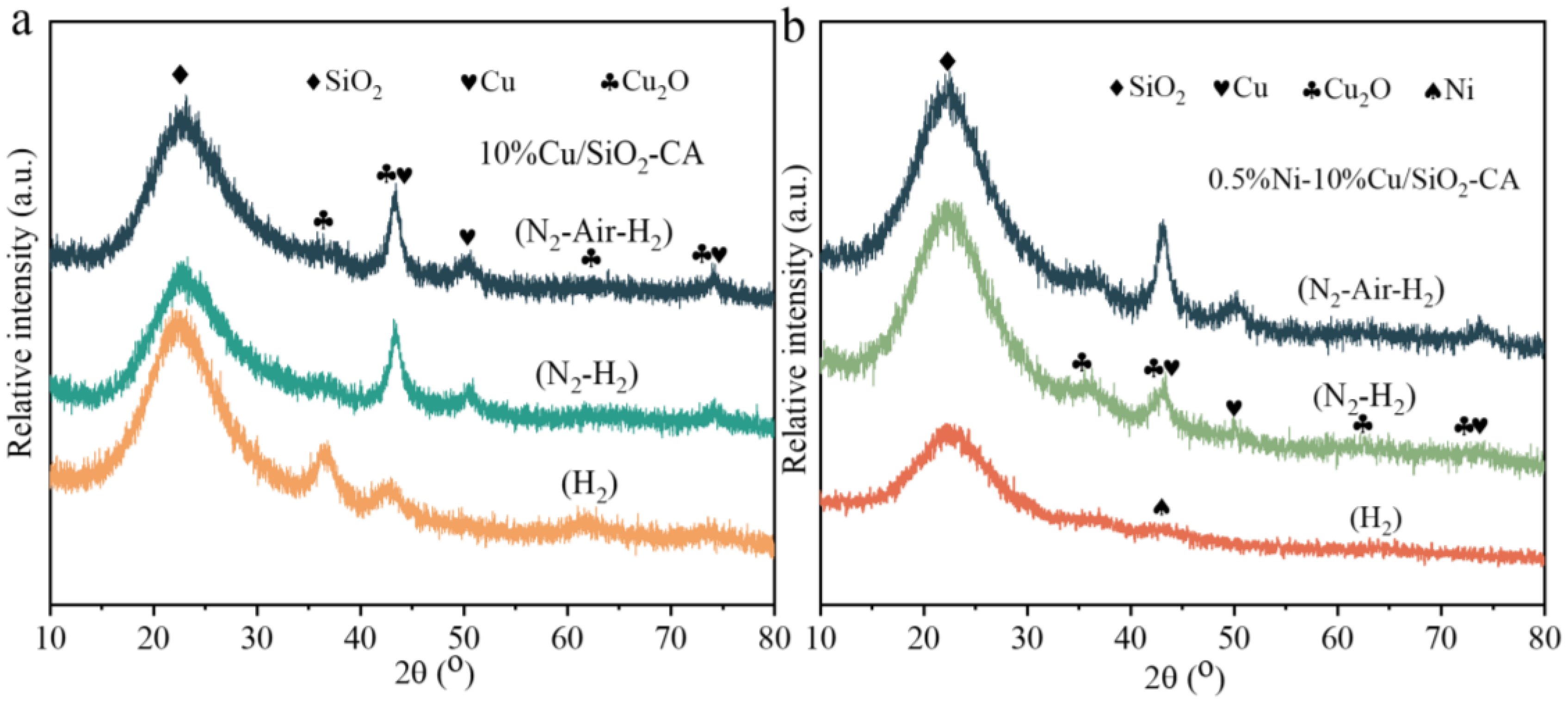
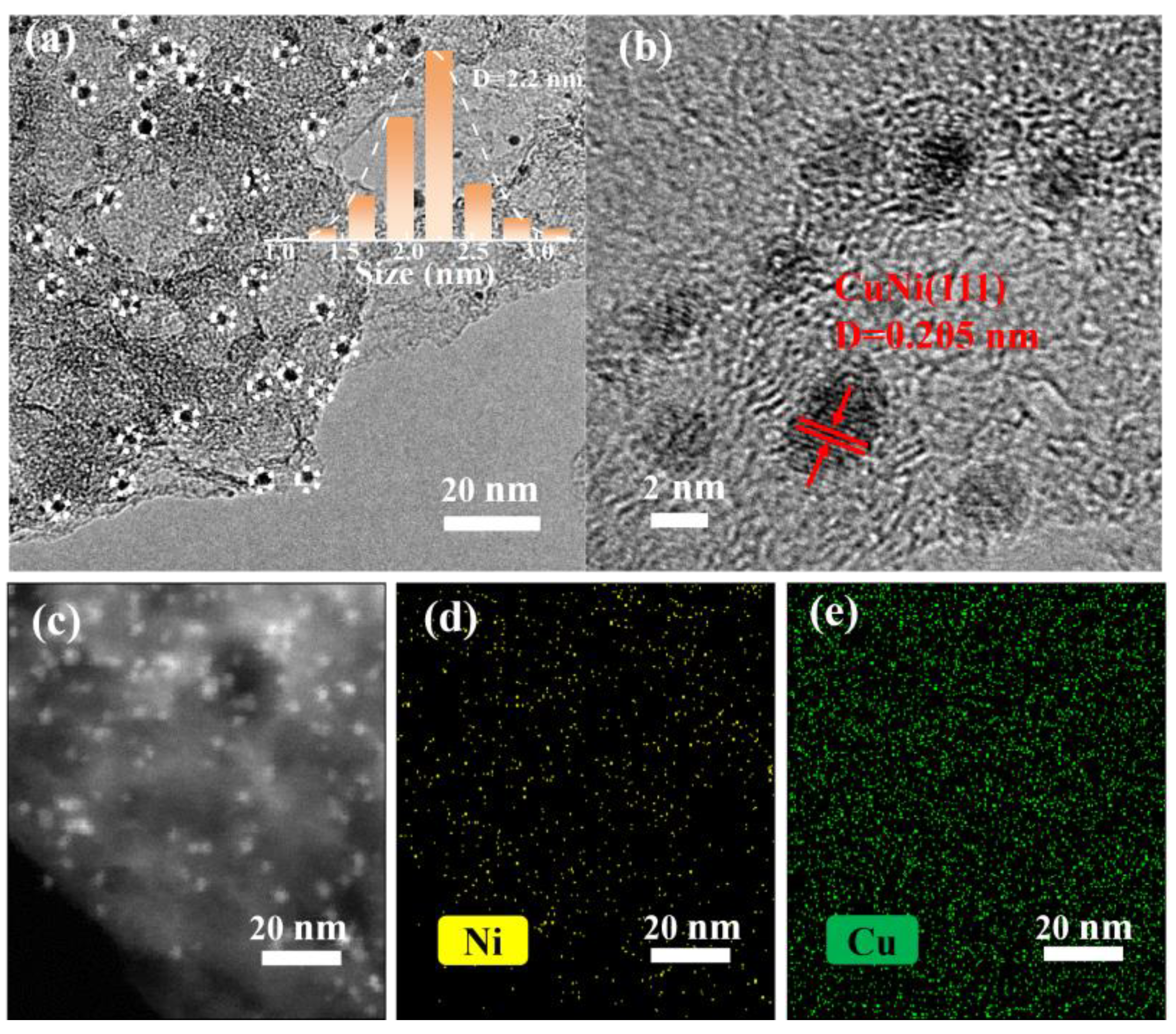

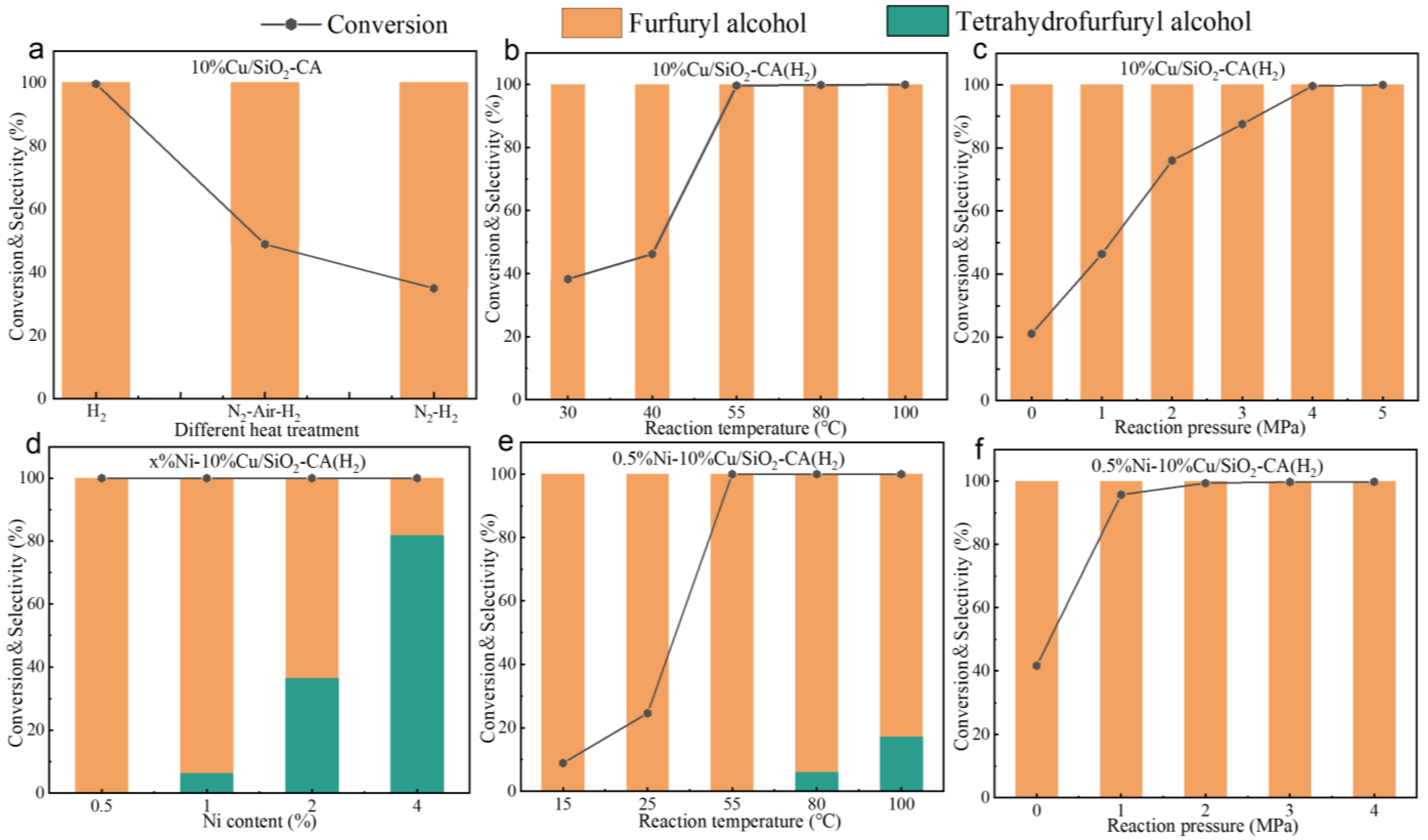
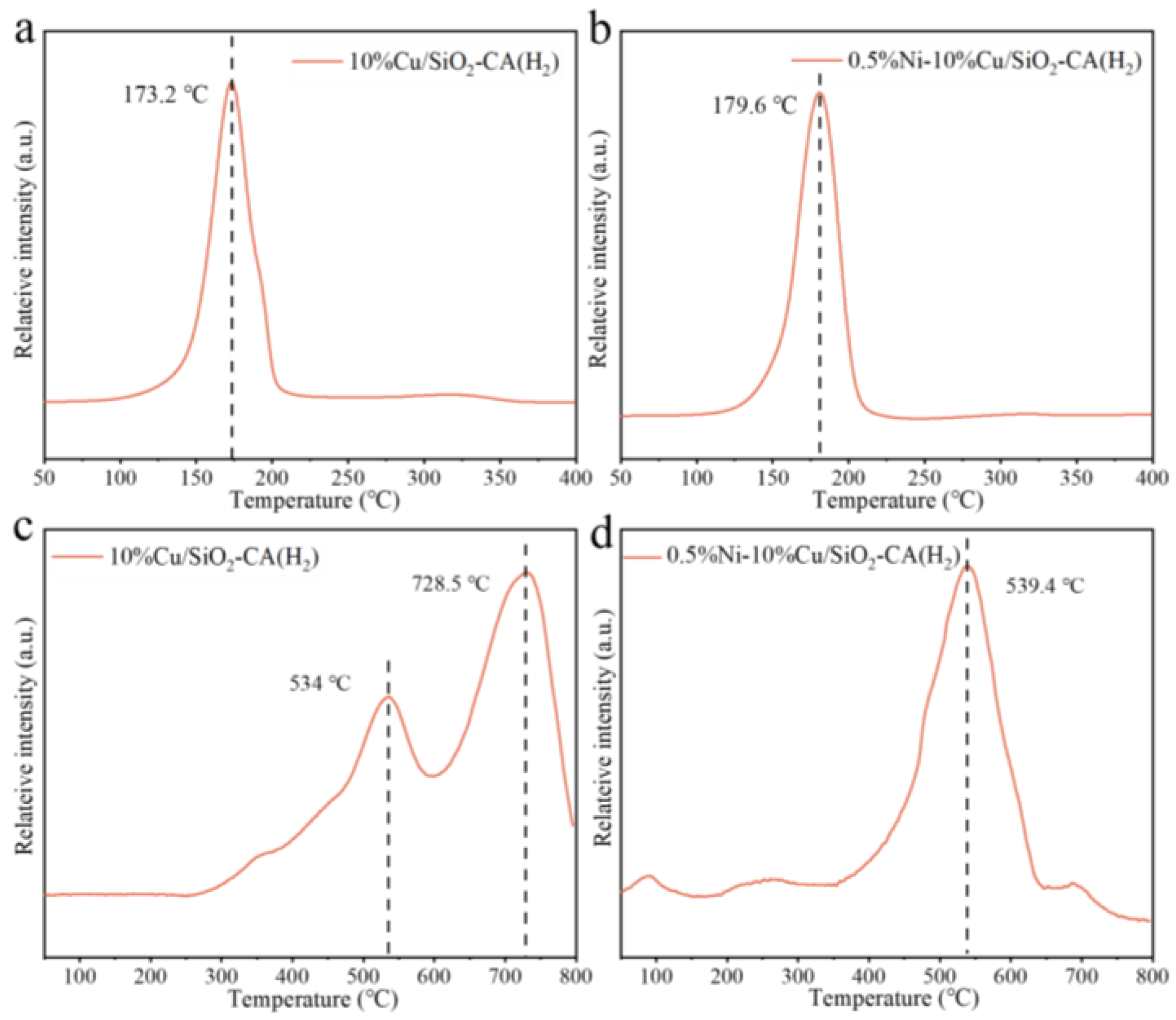
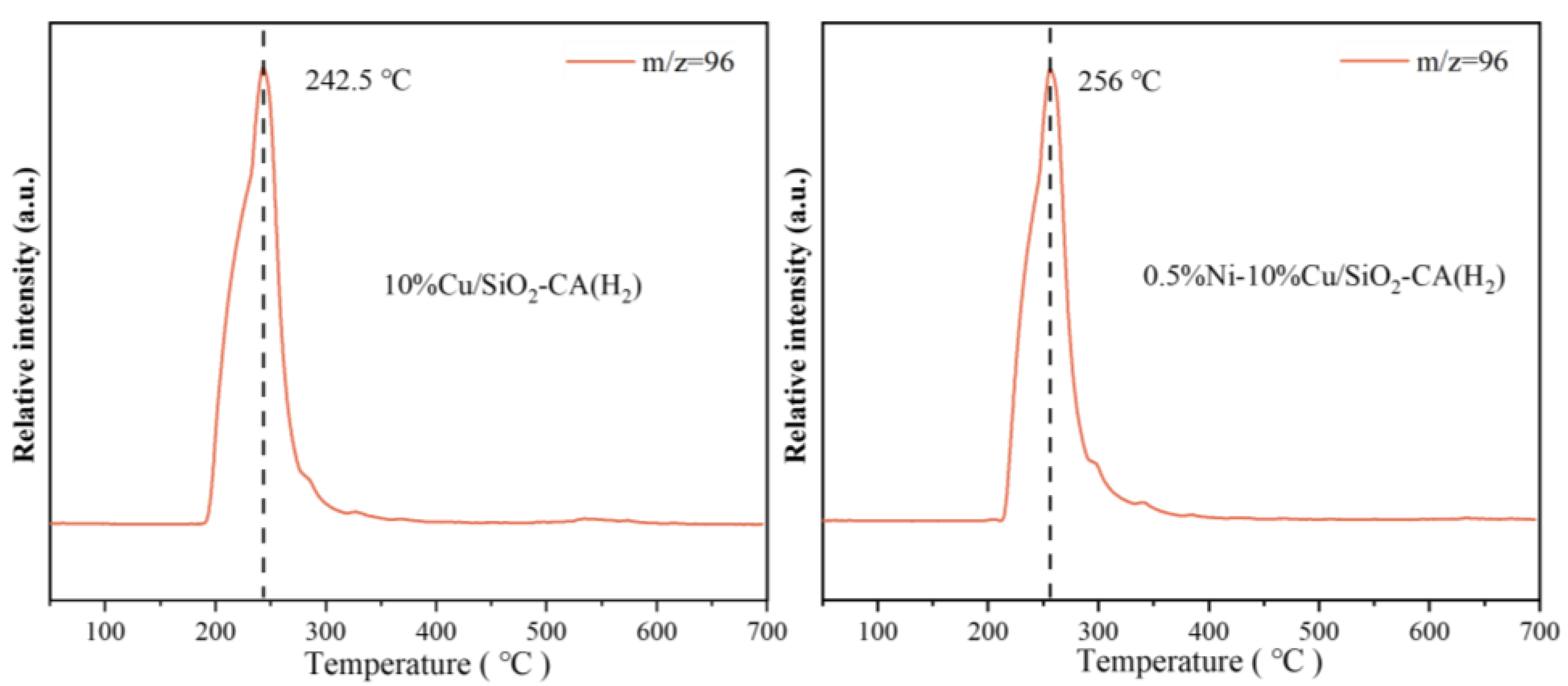
Disclaimer/Publisher’s Note: The statements, opinions and data contained in all publications are solely those of the individual author(s) and contributor(s) and not of MDPI and/or the editor(s). MDPI and/or the editor(s) disclaim responsibility for any injury to people or property resulting from any ideas, methods, instructions or products referred to in the content. |
© 2024 by the authors. Licensee MDPI, Basel, Switzerland. This article is an open access article distributed under the terms and conditions of the Creative Commons Attribution (CC BY) license (https://creativecommons.org/licenses/by/4.0/).
Share and Cite
He, D.; Liang, Z.; Gu, J.; Sang, X.; Liu, Y.; Qiu, S. Development of Robust CuNi Bimetallic Catalysts for Selective Hydrogenation of Furfural to Furfuryl Alcohol under Mild Conditions. Catalysts 2024, 14, 683. https://doi.org/10.3390/catal14100683
He D, Liang Z, Gu J, Sang X, Liu Y, Qiu S. Development of Robust CuNi Bimetallic Catalysts for Selective Hydrogenation of Furfural to Furfuryl Alcohol under Mild Conditions. Catalysts. 2024; 14(10):683. https://doi.org/10.3390/catal14100683
Chicago/Turabian StyleHe, Deqin, Zheng Liang, Juwen Gu, Xuechun Sang, Yujia Liu, and Songbai Qiu. 2024. "Development of Robust CuNi Bimetallic Catalysts for Selective Hydrogenation of Furfural to Furfuryl Alcohol under Mild Conditions" Catalysts 14, no. 10: 683. https://doi.org/10.3390/catal14100683
APA StyleHe, D., Liang, Z., Gu, J., Sang, X., Liu, Y., & Qiu, S. (2024). Development of Robust CuNi Bimetallic Catalysts for Selective Hydrogenation of Furfural to Furfuryl Alcohol under Mild Conditions. Catalysts, 14(10), 683. https://doi.org/10.3390/catal14100683






